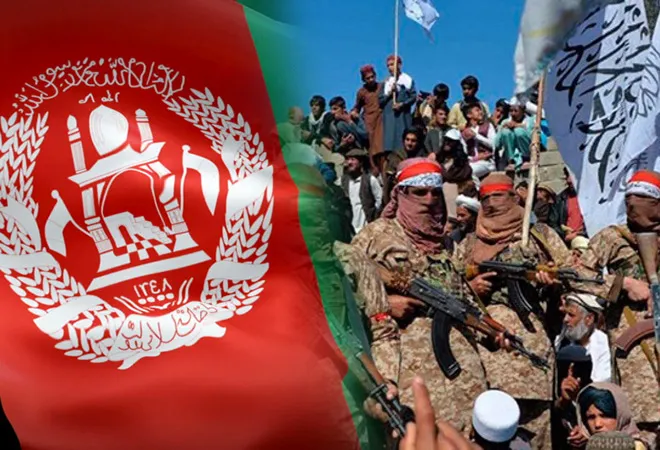
The Taliban have
captured Kandahar, the second most strategically important city in Afghanistan, as they continue their lightning advance towards capital Kabul. The shocking speed and easiness of the Taliban military march with which provinces and key cities fell to them in quick succession in just a matter of days, is a fitting epitaph to the failure of the 20-year American mission in Afghanistan as it finally winds down this month.
Kandahar, once their stronghold, has a special significance to the Taliban as it is their spiritual capital and the birthplace of the founding leader, Mullah Omar. Kandahar is also pivotal as a leading trading, industrial, and agricultural hub of the country which has an international airport.
The Taliban now controls most of the northern Afghanistan and about a third of the country’s regional capitals. This week,
one leaked US intelligence report estimated that Kabul could come under attack within weeks, and the government could collapse within 90 days.
The Taliban now controls most of the northern Afghanistan and about a third of the country’s regional capitals.
In the ferocious and brutal Taliban march, in which important cities such as Kandahar, Ghazni, Herat, and Laskhar Goh in different parts of the country fell within a matter of days with the government forces simply fleeing the battleground, underlines the
unpalatable truth for the Americans that as it completes its mission this month, 20 years and
blood and treasures worth 2,600 causalities and US $2 trillion later, it is still an awful, costly failure that they leave behind, a failure which will vex them in future. Each Taliban offensive not just erodes the stability of the fragile unity government in Kabul led by President Ashraf Ghani and debilitates the national military, both of which the US struggled mightily to prop up, but it also serves as a grim reminder that the longest war in American history has failed to achieve its twin objectives of nation-building and creating a robust Afghan military force to protect the nation.
That is the assessment the US military itself seems to have made. “Strategic momentum appears to be sort of with the Taliban,” General Mark Milley, the chairperson of the US Joint Chiefs of Staff,
admitted in Washington on July 21. He said at the time that more than 200 of the 419 district centres were under Taliban control, up from just 81 district centres a month ago.
His euphemism of “strategic momentum”, in reality, is the stark reality of the steady loss of territory by the US-backed weakly regime whose corrupt, demoralised, and desertion-prone military forces were getting outflanked by insurgent forces. In Afghanistan, every offensive is either part of the Taliban’s drive to increase its share of territory in outlying parts of the country or to completely demoralise the Afghan National Defense and Security Forces (ANDSF). In this, they are winning. Despite the Pentagon pouring billions of dollars into arming and training the ANDSF, the force has cut a sorry figure, steadily losing ground to insurgent groups while suffering record casualties and desertions. A
report released in early 2017 by the US Special Inspector General for Afghanistan Reconstruction (SIGAR) cited wholesale corruption and demoralisation as major reasons for this. The quarterly reports of
SIGAR were quite frank and forthright in painting a poor picture of the US mission in Afghanistan.
In Afghanistan, every offensive is either part of the Taliban’s drive to increase its share of territory in outlying parts of the country or to completely demoralise the Afghan National Defense and Security Forces (ANDSF).
The reason for this is not far to seek. In Afghanistan, quick fixes had been the preferred American strategy from the beginning. From 2001, after it invaded Afghanistan, it relied majorly on anti-Taliban Afghan warlords, some of them such as
General Rashid Dostum were synonymous for savagery, and an unreliable ally Pakistan to sustain its mission. The warlords were keen to grab power with American backing, but Pakistan was simply arm-twisted by President George W. Bush’s famous “you are either with us or against us”
ultimatum. The military establishment Pakistan that directs the country’s foreign policy, which promptly decided to offer
asylum to the top Taliban leadership after its rout from Kabul, saw another golden opportunity to milk America of vast fortune as it had done during the Afghan jihad from 1980 to 1988. This time, however, the difference was that Islamabad was far less enthusiastic in do Washington’s bidding.
Another example of the quick fix was in 2017, as when the Donald Trump administration vastly
scaled down the objective of the US mission, it also decided to send a few thousand additional American troops, including hundreds of Special Operations forces, to Afghanistan in a mini-surge to stablise the country. President Trump called his approach “principled realism” and said it as in keeping with the “America First” approach of his administration in which he wanted to get out of the mess as quickly as possible. However, the “principled realism” turned out to be as misplaced as every other the US attempted. Even the mini-surge could not stop the battlefield momentum of the Taliban. If the US could not win the war or force the Taliban to a political settlement when the ANDSF had 130,000 troops at its height, how can it do so with only “a few thousand”? It could not prevent the Pakistani establishment from double-dealing and supporting the Taliban’s Haqqani network, which along with narcotics trade kept the insurgency going. When that approach failed, the US somehow got the Taliban around for the
Doha Peace deal with Afghanistan, which now lies in ruins with the Taliban projected conquer Kabul.
If the US could not win the war or force the Taliban to a political settlement when the ANDSF had 130,000 troops at its height, how can it do so with only “a few thousand”?
It appears that the Taliban is on the way to triumph and Afghanistan is set to have a rerun of their brutal rule from 1996 to 2001, wiping away all the socioeconomic progress the country has made in 20 years. President Joe Biden has set a formal end to the US military mission in Afghanistan for August 31 as he looks to disengage from a conflict that began after Al-Qaeda's attacks on the US on September 11, 2001. Almost all US troops, except those protecting the embassy in Kabul and airport, have left the country.
President Trump had dramatically narrowed the scope of the US mission in 2017 down to a mere Taliban guarantee that they will never again allow Afghanistan to become a safe haven to launch an attack on the West, mainly America. However, with the Taliban gaining ground in Afghanistan so quickly and the US appearing completely clueless how to stop it, the so-called historic peace deal the Trump administration piloted between the US and Taliban of February 29, 2021 has collapsed. The Taliban
has not changed a wee bit since 2001, and how it will bring them about to keep this one guarantee is the question that would haunt the US in future.
The views expressed above belong to the author(s). ORF research and analyses now available on Telegram! Click here to access our curated content — blogs, longforms and interviews.



 The Taliban have
The Taliban have  PREV
PREV


